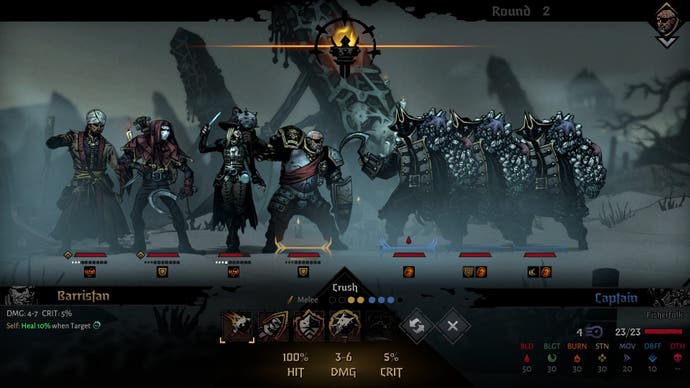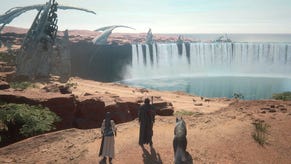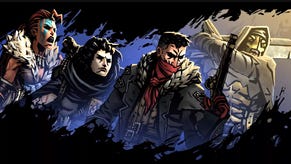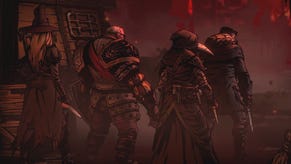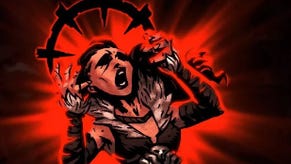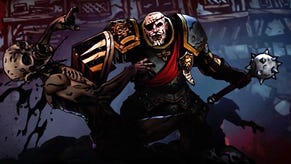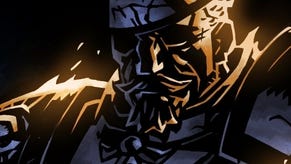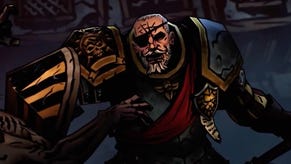Darkest Dungeon 2 review - a Lovecraftian roadtrip RPG of thrilling and suffocating intricacy
Thelma and Cthulhouise.
I find it almost as hard to summarise Darkest Dungeon 2 as I do to survive within it. It has a way of engulfing my mind, much as its squalid landscapes of rot and flame are always threatening to swallow up the lonely stage coach that is, to all intents and purposes, the game's star. I'd say I can't see the wood for the trees, but it's more that I can't see the rancid fleshpits for the piles of skulls. Still, here's a tentative, top-down perspective: this is more remake than sequel, an engrossing new version of 2016's nastiest town-and-dungeon RPG, which swaps overseeing a small army of fragile anti-heroes for leading just four along branching, apocalyptic roads towards an ominous mountain and its retinue of Lovecraftian bosses. What was once a kind of hellish workplace simulator has become the world's worst commute.
It has the same broad rhythm as the first game: levelling up characters and the world through exploration and battle, while keeping a lid on the escalating effects of stress and mental or physical illness. But it lashes the key fixtures to a new roguelike campaign format and so, weaves the strategy layer a touch more directly into travel and combat. Rather than sending parties into the catacombs and retreating to a hamlet to patch up their minds and bodies, you trundle across randomly arranged regions from inn to inn, gathering resources and replenishing yourself enroute while battling a huge menagerie of undead woodchoppers, incendiary fanatics and tentacled cosmic invaders. Your coach follows the road automatically - the horses, mercifully, appear to be unkillable. It only requires you to steer at junctions, though you can tug on the reins to crash through piles of debris in the hope of scavenging a consumable item. A busy fold-out UI, meanwhile, grants access to inventories, character screens and your map, which populates itself with landmarks, hazards and, worst of all, question marks at the entrance to each region.
The visuals have been pumped up, the original's hacked and bloodied Hellboy aesthetic wrapped around animated 3D character models, the old pop-up book dungeons cut apart and spread out to form vast, unholy cities, farmlands, forests and coastal villages. There are tweaks and tucks aplenty at the level of the battle system, too, which is clearer and snappier and more oriented toward collaboration between party-members. Still, this is largely a game not of additions, but fiendish rearrangements, which slither about in my head like footloose heroes knocked out of formation, defying me to separate one game from the other.
 Let's Play Darkest Dungeon 2 - THE END IS HERE! Darkest Dungeon 2 Gameplay, Reaction, & Early Access
Let's Play Darkest Dungeon 2 - THE END IS HERE! Darkest Dungeon 2 Gameplay, Reaction, & Early Access
The mountain is the source of the world's apocalypse, and the site of some occult crime committed by the story's off-screen protagonist, who lurks in a shattered borderland at the other end of the map. Each run at the mountain is an attempt at Confessing that crime, narrated once again by the wonderfully sepulchral Wayne June, with Confessions split into themes such as "Denial" and "Resentment" that decide how many regions you'll need to travel through, what criteria you'll need to meet on the way, and which boss you'll face at the end, while applying themed modifiers to other enemies - Resentful foes, for instance, may gain a buff when they take damage.
Defeat is routine, and the bloody compost from which victory eventually springs. Whether successful or not, each run earns candles to unlock new items, hero classes and subclasses before you choose your next party and set out afresh. You can acquire new hero abilities by delving into their invariably tormented backstories at shrines along the route. These unlockable abilities persist beyond defeat, but in other respects, your heroes are different people each time, with random positive or negative Quirks such as a debilitating phobia of animals, or tracker skills that expose the landmarks ahead. You can also flesh them out differently in each run by upgrading their abilities at inns - outfitting your Occultist with an extra debuff for his Weakening Curse, or adding a shield's worth of damage mitigation to your Man-At-Arm's defensive stances. The game thus strikes a solid, over-arching balance between permanent progression and letting you alter your tactics whenever you're driven back to the borderlands.

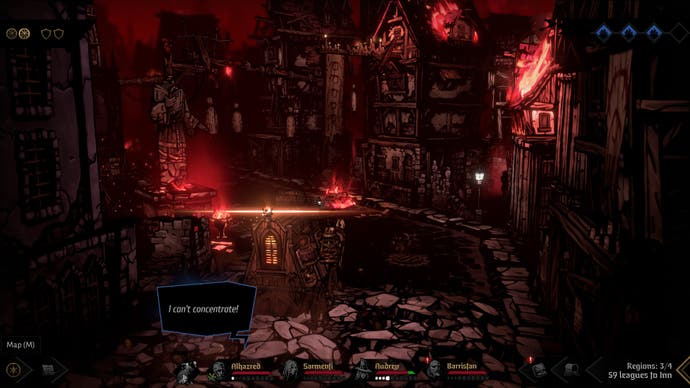
All the roads you travel eventually lead to the next inn, but each takes you past a different set of locations. One route might lead to the Hospital, where you can pay to have diseases or unhelpful Quirks removed. Another might spirit you off to a Lair, home to a regional boss you'll need to defeat to gain access to the mountain during later Confessions. Choice of route is shaped by a fairly dizzying assortment of overarching world variables and resource pressures. As in Darkest Dungeon, you bear a flame of hope which strengthens you or weakens enemies when blazing brightly. Replenishing it is fiddlier, however - rather than simply expending torches, you'll need to do hopeful things, like helping out camps of refugees.
You'll also encounter rips in reality which add to the world's Loathing when you barge through them, accelerating the rate at which your flame gutters out, and strengthening the direful Cultists you must fight just before reaching the next inn. Some routes also pass over rough ground or into ambushes that damage your coach; wreck it completely, and you'll need to fend off ambushers while one randomly chosen hero takes time out to perform repairs. To top it all off, your inglorious adventurers may have a preference about which road to follow, accumulating stress when you ignore their wishes.
It's a lot to grok, even for a seasoned Darkest Dungeon player, but after a few hours, you hack this thicket of victory conditions, creeping perils and dubious opportunities down to some simple opening questions. Am I actually trying to reach the mountain in this run, or am I just out to gather candles and unlock stuff? If I'm mounting a raid on those terrible peaks, which heroes do I need for the intervening bosses I intend to tackle, and how should I upgrade their abilities? Should I aim to clear out a Lair early on, so I have time to rest and repair my heroes before the final encounter, or in the penultimate region, once my posse of Madder than usual Maxes are fully powered-up?
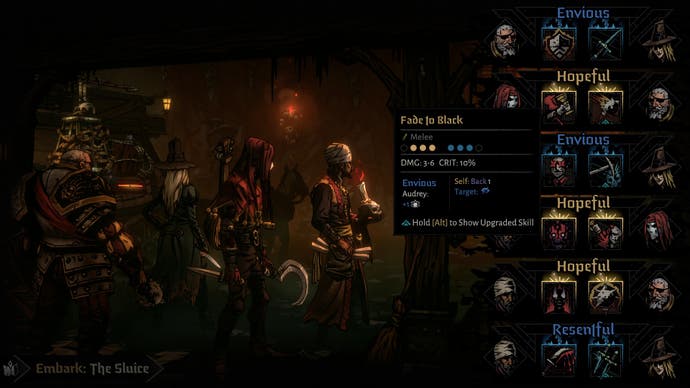
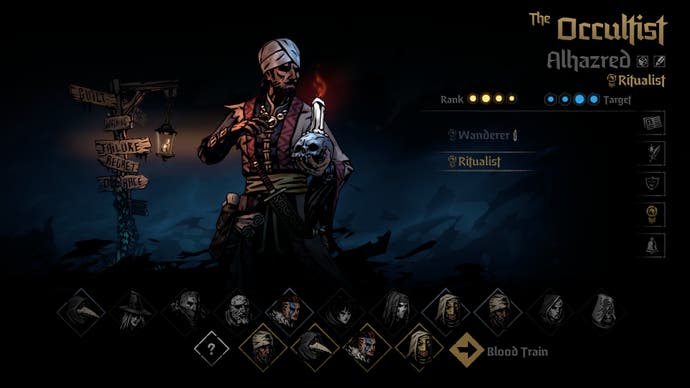
Whatever your answers to the above, you must try your best to make your party members get along with each other. In addition to the old Stress system, heroes now have a numerical Affinity for each of their comrades, which wobbles up and down over the course of battles and encounters, eventually solidifying into a positive or negative relationship. These relationships affect specific abilities, applying an effect to the other character in the relationship when that ability is performed.
So for instance, I had a Man-at-Arms who regained health every time his beloved, the Jester, opened somebody's aorta (romance isn't dead in the world of Darkest Dungeon, but it does generally involve quite a lot of death). Less constructively, I had a Grave Robber who hated my Vestal so much she vengefully halved her own damage output whenever the Vestal healed her. These torrid intimacies and grudges part-replace the first game's Afflictions and Virtues. Heroes still have meltdowns or less often, rally themselves when they reach maximum stress, but the fallout isn't as lingering: lose or gain a big whack of health, while panicking or inspiring your comrades.
Darkest Dungeon 2's relationships can be decisive later in the game, either cushioning your party against the raw overkill of the Confession bosses, or sabotaging you so hilariously that it's probably worth ditching the run. They form part of a larger emphasis on collaboration in combat, which has been extensively retuned. The rudiments are as before: heroes and enemies form lines of up to four, taking turns according to their Speed stats. There's the same, very gratifying sliding-puzzle emphasis on positioning: most abilities both target, and can only be performed from certain ranks, which means combatants can knock adversaries out of formation to deny them access to their best moves.
The first difference you notice is that the presentation is cleaner, and the variables less, well, variable. I'm going to do an abysmal job of explaining this, but Red Hook has essentially rejigged the supporting maths so that status effects such as Vulnerable all affect accuracy or damage percentages by chunky, reassuring multiples of 12.5% or 25%. This makes it less laborious to calculate whether it's worth, for instance, having your blinded Highwayman risk a shot at a skeleton crossbowman, or use his Take Aim ability instead to gather his wits. The combat UI remains baroque, but the new vocabulary of counters for status effects is also easier to parse.
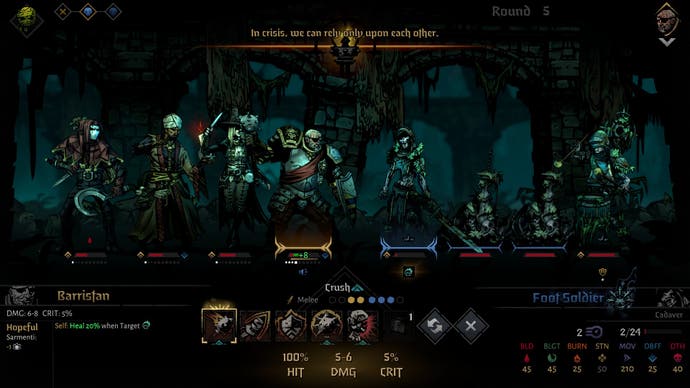

The second thing you notice, even before you start cultivating those character relationships, is the greater importance of team-ups. Many abilities saddle their targets with a combo counter, and characters and abilities are often more potent when targeting opponents who have combo counters. It makes for some enjoyable tactical chemistry. The Occultist, for instance, applies a combo counter when yanking enemy supports into the front rank with his tentacle pets. This makes him a great friend indeed to the Leper, who deals damage like it's going out of fashion, but also has a high chance of blinding himself each turn thanks to his cumbersome metal mask - unless, that is, he's targeting an enemy with a combo counter.
The heroes themselves are familiar from the first game: there's only one new face right now, the Runaway, a sneaky front-liner who uses fire both to damage and to heal. But each has been artfully redesigned, and it's a pleasure to discover how. The Vestal, for example, now accumulates Conviction each turn, which she can expend to set targets on fire with her lightning bolts. She can also "consecrate" a spot in the line so that any hero standing there gains a buff, which is terrific if your other heroes are prone to moving (or being moved) around. Red Hook has trimmed back some of the character customisation, which makes hero playstyles easier to grasp and develop. Each ability has just one upgrade, and equipment now consists of a choice of two trinkets that typically boost one stat while lowering another.
If it's a little more digestible than the original, Darkest Dungeon 2 remains a brutal experience, both in terms of individual scraps and the pressure to win them without bloodying and upsetting your heroes so much as to render overall victory impossible. Bosses, especially, shower you with damage-over-time effects and bespoke hazards - strangling heroes with vines, dragging them underwater or deluding them into gobbling down piles of toxic meat. Good luck defeating these grander grotesques without foreknowledge of their abilities. The combat is surprisingly forgiving in key respects, however - the returning Death's Door mechanic grants heroes a chance of surviving damage received after they fall to zero health. And it's rarely actively unfair: enemies have pronounced strengths and weaknesses, always grounded in their visual and narrative design, which make battle a satisfying conundrum once you've gleaned all their nasty habits.
As in the first game, the ethic of progress-through-punishment goes hand-in-hand with an openly and at times, offputtingly ghoulish portrayal of injury and illness. The game takes a medieval delight in the spectacle of mental or physical suffering. Every foe is some kind of study in bodily corruption and decay. It also often treats life-altering conditions and trauma as tacit super-powers: the Leper's resilience and potency are framed in terms of his leprosy, while the Runaway's fixation with fire stems from a history of abuse. Depending on your experience of such things, you may find this cathartic in its awfulness, or a repellent and tawdry piece of misrepresentation. You might also have mixed feelings about how Red Hook handles the grottier elements of Lovecraft, whose fantasies about cosmic monsters were laced with racial and class prejudice - a legacy that lives on discreetly in Darkest Dungeon's leviathan-worshipping fishpeople and subterranean swinefolk.
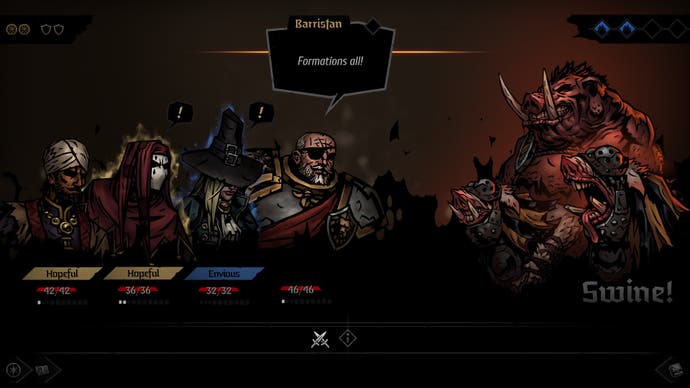
The other take on Darkest Dungeon's circus of deterioration is that it's all one big metaphor for contemporary workplace burnout. As I learned when I interviewed them several years ago, the idea of accumulated stress leading to afflictions that thwart or warp your actions reflects Red Hook co-founder Chris Bourassa and Tyler Sigman's own experiences of the hard graft of software development. In addition to modelling such stresses and strains, the original Darkest Dungeon felt designed to fit in amongst them. I myself found it disturbingly convenient and compulsive as a lunchbreak game, with its 15-30 minute dungeon loops.
For all its change of genre and refocussed, cleaned-up combat, I'm not sure I see Darkest Dungeon 2 fitting into my life the same way. It's a success without doubt, a clever and robust reinvention that might keep you occupied for 50 hours or more (much more, I suspect, if you want to unlock every last feature). But where the first game was a breath of foul, abyssal air for fantasy RPGs, Darkest Dungeon 2 is another chance to wallow in the mire. The new roguelike format works well, and the smaller tweaks are devious and delightful to uncover. But the overall emotions I feel playing are the same: the deflation of failure and the triumph of a hard-won breakthrough slowly disintegrating into the callous, managerial satisfaction of feeding heroes into a mincing machine till at long last, the mincing machine breaks down.
